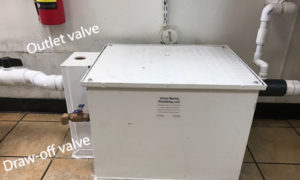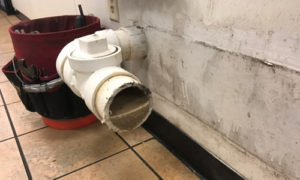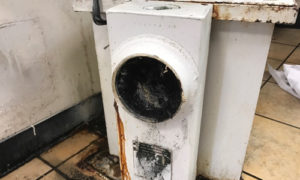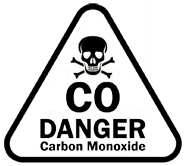Do you own or manage a restaurant? Do you periodically skim off the grease trap? If you don’t you’re going to have severe drain clogs and sewage backups. Here’s how to properly skim off a grease trap and prevent down time.
What’s a grease trap?
It’s an interceptor (or grease recovery device) usually connected to the outlet side of a three bowl scullery sink. It has an internal baffle that restricts and collects all of the fatty oils and greases that wash down the kitchen drain.
Where is it needed?
Where ever food is commercially baked, fried, or prepared cold for public consumption. For example, the following type food establishments need a grease trap:
- restaurants
- hospital kitchens
- bakeries
- pizza shops
Why is it required?
A grease trap is required to prevent excessive food oils from entering into the public sanitary sewer system. If restaurants or commercial kitchens drained greasy dishwater into the public sewer system, it would create a big problem. The wastewater treatment plants would have to increase monthly treatment fees on everyone’s water bill. Now would you want an increase on your monthly water bill? Yeah, me neither.
Skimming is necessary
Here’s a quick rundown of the steps. I’ll walk you through in a little more detail below.
- Close the outlet ball valve
- Pour boiling water down the sink drain connecting to the trap
- Repeat this step several times to get the solid grease to liquefy and come out of the draw-off valve
- Run hot tap water so you can draw off the greasy film
- Once you get grease free water, the trap is properly skimmed off
- Cover the bucket and save it for recycling pick up

To skim a grease trap you want to first close the outlet ball valve, then boil water and pour down the sink drain connecting to the trap. Be careful not to get scalded while handling the hot water. You may have to repeat this step several times to get the solid grease to liquefy so it will come out of the draw-off valve.
After you have poured boiling water into the trap, then run hot tap water so you can draw off the greasy film. Once you get grease free water, the trap is properly skimmed off. Cover the bucket and save it for recycling pick up. You should perform this maintenance at least twice a month. Here’s what happens if you don’t skim off your grease trap:


Proper maintenance
A grease trap needs maintenance no beating around the bush. If it’s not periodically skimmed (or cleaned out), it will end up being useless and require premature replacement. Before complete failure, it will start to cause severe drain backups. That means messy cleanup and downtime, in addition to the service calls to unclog the drains.
If you don’t want to bother servicing your grease trap, click here to schedule a grease trap service appointment with Vince a Pittsburgh plumber who knows how to properly clean grease traps and install them.


